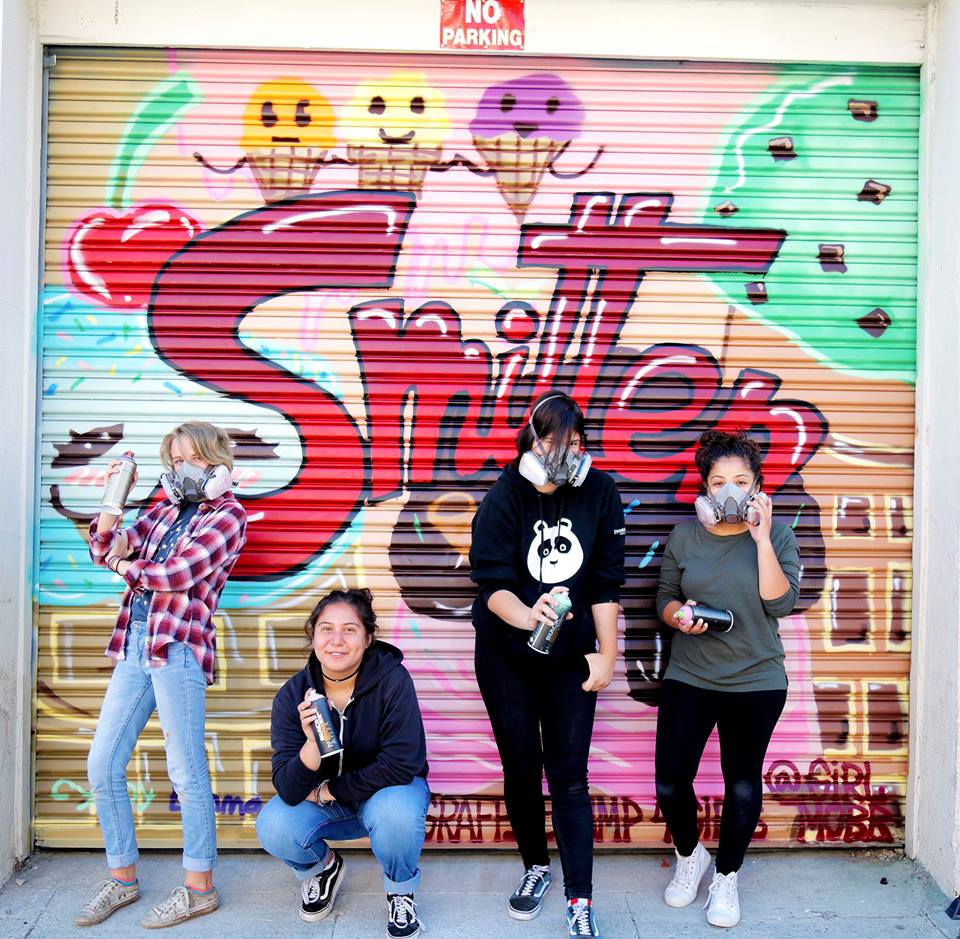Graffiti Camp for Girls is breaking up the boys’ club of street art
“I was a disgruntled teenager. My mom moved us out to the country while I was still in high school and there was nothing to do. I basically just wanted to get into trouble,” says Nina Wright, aka Girl Mobb, on how she first got into graffiti painting on barns in rural Ohio.
Though her initial interest in street art was because it offered her a way to “get into trouble,” she found she was getting more artistic in her approach as she progressed. At the age of 22 she moved out to the Bay Area and began exploring different avenues of street art: spray paint, letters, wheat paste, and so on.

Wright was in an all-male graffiti crew there, which didn’t bother her…at first. But there weren’t any other women for her to paint with – “just all dudes all the times” – and she only knew a handful of other women street artists that she would occasionally show with in a gallery. The same handful she always would show with every time she showed in a gallery.
“I just wondered why it was like this and thought about what I could do to explore that and do some mentorship to get more women involved,” she says.
This led to her partnering up with Deirdre O’Shea, who has two decades of nonprofit experience, and together they launched Graffiti Camp for Girls, offering women-mentored graffiti classes for young women. The project won a grant last April from Southern Exposure to get started.
They have had 10 camps since then and Wright says they are speaking to groups across the country about hosting their own camp. Groups from all over the world have expressed interest in it.
“There has been a lot of interest in it and I have a lot of people contacting me,” Wright says. “Whoever is interested and wants to support the project will contact me, so we have a lot of youth organizations, some business and galleries, schools, and teachers who will contact me to bring the program to their schools.”
There are several more camps in the works in the Bay Area and Cincinnati, and they even recently held some in Cambodia. In the Bay Area there is an application process for students interested in attending, but in all other areas right now the partner organization brings in their own students.
The standard class is held over five days for three hours a day. During the school year it’s only on weekends, and during summer break it’s held over one week, Monday through Friday.
Wright brings in other women artist friends who help mentor the students and says she has met a lot of other women artists since launching who want to help the project either by volunteering or by starting one in another city. “The more people who get involved the bigger and more spread out it gets,” she says. “I feel like it’s just going to keep getting bigger.”
The overall goal of Graffiti Camp for Girls is, she says, to get women to be less intimidated and be a part of this public art process.
“You rarely see women do it and when you do, it’s refreshing to me,” says Wright. “The truth is, the culture is still very male-dominated. It’s not encouraged for women to be into street art and be in these louder street forms. Every time I question the validity of the project, we will have a volunteer in early 20s and she’s super scared and nervous, but at the end of the class we see her being more courageous and brave and it becomes more natural for her. Then the project makes sense to me again. Every time I do this class it makes total sense.”

(1) How do you like to collaborate?
With Graffiti Camp for Girls, most walls give us free reign to do whatever we want. We talk to the girls to see what they want to paint and go from there. They all pitch in ideas. The process has been pretty easy and pretty natural. The ideas from the students have been more imaginative than anything I could come up with. We just talk things over and sketch things out until we come up with something they like.
(2) How do you a start a project?
Breathe deep then dive in with cockiness.
(3) How do you talk about your value?
The value in it is that it teaches a new skill they might not otherwise learn. It’s really good for building confidence and self esteem as well. Something like Graffiti Camp for Girls isn’t done very much; I haven’t seen it done very often, if at all, around here. It gives the girls an opportunity to try something new that’s aggressive.
(4) How do you define success?
If at the end of the camp the girls are confident with spray paint and in the work they’re producing and less timid, that’s the goal.
(5) How do you fund your work?
We charge a student fee but we also make it accessible to everybody by giving out scholarships to those who can’t afford it as well. We’re looking into more grants and registering as a nonprofit so we have more access to grants.
